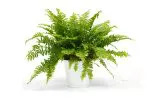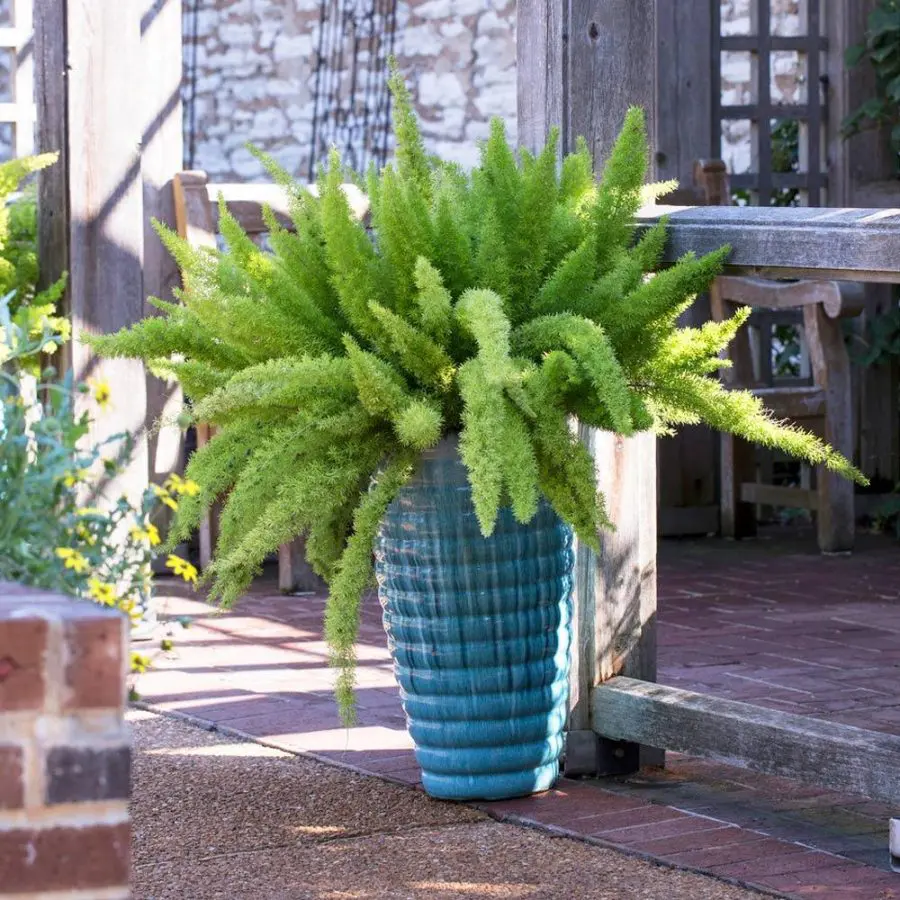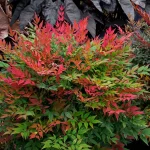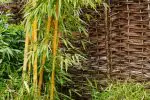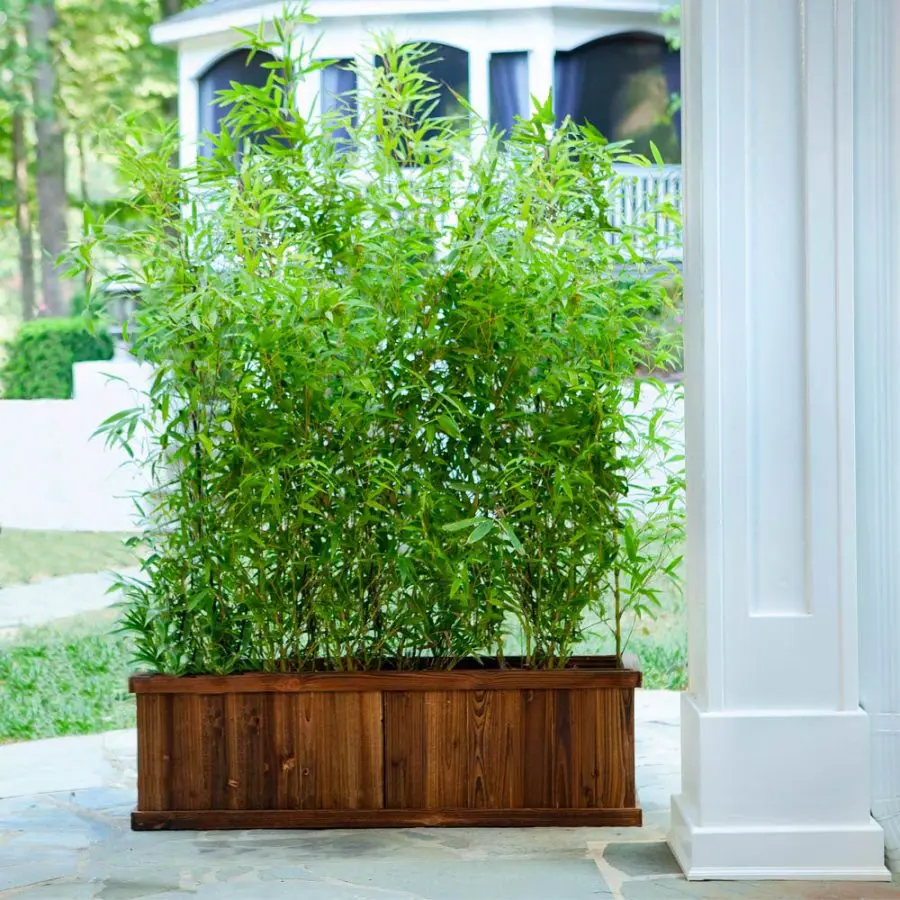This post contains affiliate links. If you buy something from one of our links we may earn a commission. Thanks
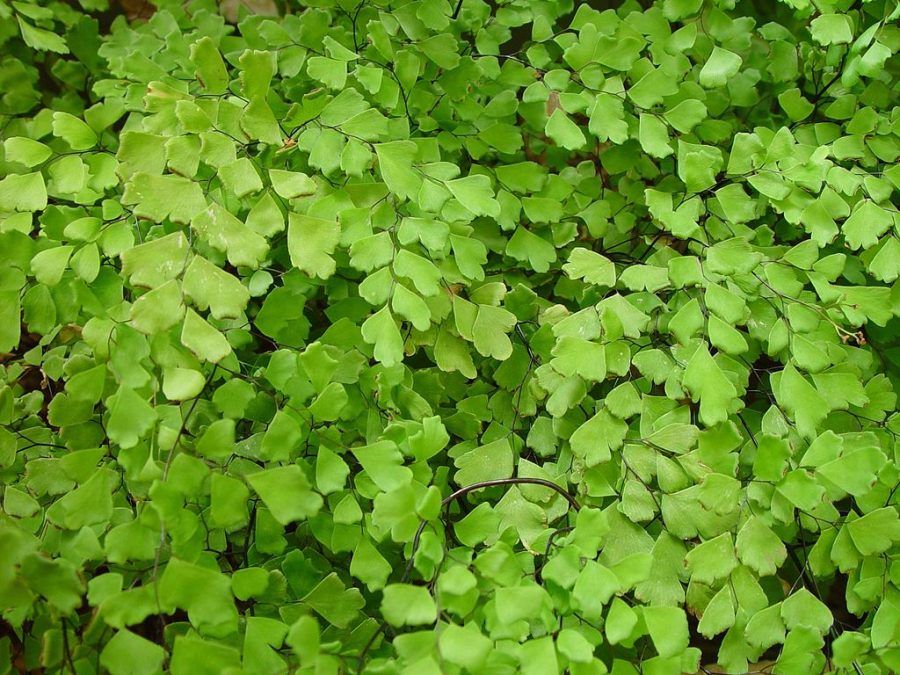
Discover the secrets to keeping your maidenhair fern thriving indoors! Learn everything you need to know about maidenhair fern indoor care in this helpful guide.
Maiden Hair Fern indoor care involves high humidity, indirect sunlight, and well-draining soil. Keep the soil consistently moist but not waterlogged. Position the plant in a bright area but away from direct sunlight. Mist frequently or use a humidity tray to maintain moisture levels. Fertilize monthly with diluted liquid fertilizer.
Welcome to the wonderful world of indoor gardening! Today, we’re going to delve into the ins and outs of maiden hair fern indoor care.
Whether you’re a seasoned grower of indoor plants or just starting out, you’re sure to love this easy-to-care-for beauty.
So, grab your potting soil and watering can, and let’s get started!
Maidenhair Fern Indoor Care
Are you looking for a new indoor plant to add to your collection? Look no further than the maidenhair fern!
Buy Maidenhair Ferns on Amazon
This delicate and graceful plant is a popular choice among indoor gardeners for its lacy fronds and easy maintenance.
But, like any living thing, this popular houseplant does require some special care to thrive indoors.
In this guide, we’ll cover all the essential tips and tricks you need to know for successful maiden hair fern indoor care.
So, get ready to green up your living space, and let’s jump right in!
A. Getting to Know Maidenhair Fern Care
Maidenhair fern is the common name for this popular fern but it is also known by its botanical name Adiantum raddianum.
It is a beautiful and delicate plant native to tropical and subtropical regions.
There are many types of maidenhair ferns in the genus Adiantum and some cultivars are recognized by the Royal Horticultural Society.
According to Wikipedia: The Andes exhibit the highest species of maidenhair ferns diversity, while eastern Asia boasts a significant diversity with China alone hosting nearly 40 species.
Adiantum ferns native to North America include Adiantum pedatum (five-fingered fern) and the closely related A. aleuticum, notable for their fronds that bifurcate and radiate pinnae on one side only.
Adiantum capillus-veneris (Venus-hair fern), a cosmopolitan species, has a native distribution that extends to the eastern continent. On the west coast, A. jordanii (California Maidenhair) is a native species.
In New Zealand, there is a rich Adiantum flora, with a total of 10 recorded species, three of which are endemic (A. cunninghamii, A. viridescens, and A. fulvum). Many of these ferns are common in the west and south of the islands.
The Maidenhair Fern is known for its thin and lacy fronds, which give it a feathery appearance.
The leaves of the maidenhair fern are usually light green, but some varieties have a reddish or bronze tint.
This plant is popular among indoor gardeners due to its graceful and elegant appearance.
Why the Maiden Hair Fern is a Popular Indoor Plant
The maiden hair fern is a great choice for indoor gardening for several reasons.
Firstly, it is one of the easiest plants and relatively low-maintenance compared to other ferns, making it an ideal choice for those who are new to indoor gardening.
Secondly, it is a beautiful and visually appealing plant that can enhance the aesthetic of any indoor space.
Lastly, it is well-suited to indoor conditions, thriving in the low light and high humidity that is common in many homes.
The Importance of Proper Care for the Maiden Hair Fern
Proper care is essential for the health and longevity of your maiden hair fern. This includes providing adequate lighting, watering, and humidity levels.
Neglecting these needs can result in yellowing leaves, stunted growth, and even plant death.
However, with a little bit of knowledge and effort, you can easily provide your maiden hair fern with the care it needs to thrive.
In the following sections, we will explore each of these needs in greater detail to help you become a successful maiden hair fern caregiver.
Light Requirements
When it comes to caring for your maiden hair fern, lighting is key.
While this plant may look delicate and dainty, it actually requires a good amount of light to grow and thrive.
In this section, we’ll cover everything you need to know about providing the proper lighting for your maiden hair fern.
From understanding ideal lighting conditions to avoiding common mistakes, we’ve got you covered. So, let’s shed some light on maiden hair fern care!
Ideal Lighting Conditions for the Maiden Hair Fern
The maiden hair fern thrives in moderate to bright, indirect light.
This means that it should be placed near a window that receives bright indirect sunlight for at least a few hours a day.
Direct sunlight can scorch the delicate leaves of the maidenhair fern, so it’s important to avoid placing it in direct sunlight for extended periods of time.
If you don’t have access to a window with enough natural light, you can also use artificial lighting to supplement your plant’s needs.
How to Provide the Proper Amount of Light
To provide your maiden hair fern with the proper amount of light, you’ll need to pay attention to its placement and adjust it as needed.
Start by placing your plant near a window that receives moderate to bright, indirect light.
If you notice that the leaves are turning yellow or brown, they may be receiving too much direct sunlight.
On the other hand, if the leaves are small or the plant is growing slowly, it may not be receiving enough light.
In this case, you may need to move it to a brighter location or supplement it with artificial light.
Effects of Too Much or Too Little Light on the Fern
Both too much and too little light can have negative effects on your maiden hair fern.
Too much direct sunlight can cause the leaves to turn yellow or brown and can even scorch the fronds.
On the other hand, too little light can cause the fern to grow slowly, develop small leaves, and lose its vibrant green color.
In addition, low light can make the fern more susceptible to pests and diseases.
So, it’s important to find the right balance of lighting conditions to ensure that your maiden hair fern stays healthy and vibrant.
Watering Needs
When it comes to maidenhair fern indoor care, watering is another essential component.
While it may seem like a simple task, watering your fern properly can be a bit tricky.
Overwatering can lead to root rot, while underwatering can cause the plant to dry out and wilt.
In this section, we’ll explore everything you need to know about watering your maiden hair fern, including how often to water it, maintain moisture levels, and how to check if your potted plant needs watering.
So, grab your watering can, and let’s get started!
How Often to Water the Maiden Hair Fern
Knowing how often to water your maiden hair fern is crucial to its overall health.
While it’s important to keep the soil moist, overwatering can lead to soggy soil. This leads to root rot and other issues.
As a general rule of thumb, you should water your maidenhair fern when the top of the soil feels dry to the touch.
However, avoid letting the soil dry out completely, as this can also be detrimental to the plant’s health.
Proper Watering Techniques
Proper watering techniques are key to keeping your maiden hair fern healthy and happy.
When watering your plant, be sure to use room-temperature water and avoid getting water on the leaves, as this can lead to brown spots or other damage.
Water the soil slowly and thoroughly, allowing the excess water to drain out of the pot’s bottom.
If your maiden hair fern is in a hanging basket or elevated location, be sure to place a tray underneath to catch any excess water.
Signs of Over or Under Watering
Overwatering and underwatering can both have negative effects on your maiden hair fern.
Signs of overwatering include yellowing leaves, a mushy stem, or a foul odor coming from the soil.
On the other hand, signs of underwatering include wilting leaves, brown tips, or a dry, cracked soil surface.
To avoid these issues, be sure to water your maiden hair fern appropriately and check the soil regularly to ensure that it’s moist but not waterlogged.
Humidity and Temperature
In addition to proper lighting and watering, maintaining the right humidity and temperature levels is also crucial for your maiden hair fern’s health.
This delicate fern thrives in warm and humid conditions, which can be a challenge to provide indoors, especially during the winter months.
In this section, we’ll explore the ideal relative humidity and temperature ranges for your maiden hair fern, as well as some tips for maintaining these conditions.
So, let’s dive in!
A. Ideal Temperature Range for the Maiden Hair Fern
Maidenhair ferns thrive in warm temperatures and don’t tolerate cold drafts or extreme temperature changes very well.
The ideal temperature range for a maiden hair fern is between 60°F to 75°F (15°C to 24°C).
Avoid placing your fern near doors or windows that are frequently opened, or in areas that experience temperature fluctuations such as near heaters or air conditioners.
Effects of Humidity on the Fern
High humidity is essential for the maiden hair fern to thrive. The fern’s natural habitat is in tropical and subtropical regions with high humidity levels.
Low humidity can cause the fern’s delicate fronds to dry out and become crispy, leading to stunted growth or even death.
Additionally, low humidity can attract pests such as spider mites and mealybugs, which can further damage the plant.
How to Increase Humidity Around the Fern
To provide adequate humidity levels for your maiden hair fern, you can take a few different approaches.
One simple way to increase humidity is to mist the fern regularly with room-temperature water.
You can also place a humidifier near the fern, or set the pot on top of a pebble tray which is a tray filled with pebbles and water.
As the water evaporates from this tray of wet pebbles, it will increase the humid air around the plant.
Another option is to group your fern with other houseplants or place it in a bathroom or kitchen, which tends to have naturally higher humidity levels.
Soil and Fertilization
The soil and fertilization routine you provide for your maiden hair fern can have a significant impact on its overall health and growth.
A well-draining soil mix with adequate nutrients can help your fern thrive, while improper soil or fertilization can lead to root rot, nutrient deficiencies, and stunted growth.
In this section, we’ll discuss the best soil mix for your fern, how often to fertilize it, and the signs of over or under-fertilization.
So, let’s dive in and learn more about soil and fertilization for the maidenhair fern!
Ideal Soil Type for the Maiden Hair Fern
Maidenhair ferns prefer well-draining soil that’s high in organic matter.
A good soil mix for the maiden hair fern should be a blend of peat moss, perlite, and vermiculite in equal parts.
This mix provides good drainage, while also retaining moisture and nutrients that the fern needs to thrive.
Coco Coir vs. Peat
When it comes to choosing a soil mix for maidenhair fern indoor care you may come across both coco coir and peat as options.
Coco coir is a sustainable alternative to peat and is becoming more popular among plant enthusiasts.
It’s made from the fibrous husks of coconuts and is highly sustainable. Peat, on the other hand, is harvested from bogs and is not a renewable resource.
While both options can be suitable for the maidenhair fern, coco coir is a more eco-friendly option.
How to Fertilize the Fern
Fertilizing your maiden hair fern can help ensure it’s getting the nutrients it needs to grow and thrive.
A balanced, water-soluble fertilizer is best for this fern, and it’s essential to dilute the fertilizer according to the instructions on the package.
It’s best to fertilize your maiden hair fern once a month during the growing season (spring and summer) and stop fertilizing during the winter months when the fern is dormant.
Importance of Proper Soil and Fertilization
Proper soil and fertilization are essential for the overall health and growth of your maiden hair fern.
The right soil mix ensures that the plant has access to the right nutrients and adequate drainage, while proper fertilization helps ensure the plant is getting the nutrients it needs to grow and thrive.
Proper soil and fertilization also help prevent root rot, which is a common issue for maiden hair ferns.
Repotting
As your maiden hair fern grows, it’s essential to ensure it has enough space to continue thriving.
That’s where repotting comes in! Repotting allows you to refresh the soil, give the roots more room to grow, and remove any dead or damaged roots.
In this section, we’ll discuss when to repot your maiden hair fern, how to do it correctly, and what type of soil mix to use.
So, let’s dive in and learn more about repotting your maiden hair fern!
When to repot the maiden hair fern:
Your maiden hair fern will need to be repotted every year or two, depending on its growth rate.
Signs that it’s time for repotting include roots growing out of the drainage holes or a lack of growth even after proper care.
The best time to repot is in the spring or summer when the fern is actively growing.
How to repot the fern:
Start by gently removing the fern from its current pot and shaking off any excess soil.
Inspect the roots for any signs of damage or rot and trim as necessary. New pots should always have drainage holes.
Fill the new pot with fresh soil and place the fern in the center. Add more soil to fill the gaps, and gently pat it down.
Water the fern thoroughly and place it in a spot with bright, indirect light.
Common mistakes to avoid during repotting:
The most common mistake made in maidenhair fern indoor care is using a pot that’s too big, which can lead to overwatering and root rot.
Another mistake is not loosening the roots enough, which can cause them to become root-bound and affect growth.
It’s also essential not to overwater the fern immediately after repotting, as this can lead to root rot.
Finally, make sure to choose the right type of soil mix, as we discussed in the previous section.
Propagation
There’s something truly special about growing your own plants from scratch, and propagation is one way to do just that.
Luckily, the maiden hair fern is relatively easy to propagate, allowing you to expand your fern collection or share it with friends.
In this section, we’ll go over the different propagation methods for the maidenhair fern, including spores and division.
So, let’s dive in and learn more about propagating your maiden hair fern!
Spores
One way to propagate the fern is through spores. Spores are tiny, dust-like particles found on the undersides of the fronds.
To propagate with spores, collect the spores and sprinkle them on top of moist soil.
Cover with plastic wrap to retain moisture and place the container in a bright, warm location.
Division
Another way to propagate is through division. To do this, carefully remove the fern from its pot and separate the root ball into smaller sections.
Repot each section in fresh soil and water thoroughly.
The best time to propagate the maiden hair fern is during the spring or summer when the plant is actively growing.
This will give the new plants ample time to establish themselves before the colder months arrive.
The most common propagation methods for the maiden hair fern are spores and division.
In addition to these methods, some gardeners have had success with rhizome cuttings, although this can be a bit trickier.
Regardless of the method you choose, be sure to provide the proper care and attention to your new plants as they establish themselves.
Using spores and division
Spores are tiny, dust-like particles found on the undersides of the fronds. To propagate with spores, you’ll need to collect them from a mature fern.
To do this, place a mature frond with spores on a piece of paper and let it dry out for a few days.
Then, gently shake the frond over a container of moist soil to release the spores.
Cover the container with plastic wrap to retain moisture and place it in a warm, bright location.
Over time, the spores will germinate and grow into tiny, delicate ferns.
It’s important to note that this process can be quite slow, often taking several months to see visible growth.
Once the ferns have grown enough to be handled, you can transplant them to their own pots with fresh soil.
Division is another common propagation method for the maidenhair fern.
To propagate by division, carefully remove the fern from its pot and separate the root ball into smaller sections.
Be sure to use clean, sharp tools to avoid damaging the roots. Once you’ve separated the root ball, repot each section in fresh soil and water thoroughly.
Propagation by division is generally a quicker method than spores, as the new plants will already have an established root system.
However, it’s important to be gentle during the division process to avoid damaging the roots or the plant itself.
Additionally, you may not be able to divide the fern into as many sections as you’d like, depending on the size and health of the parent plant.
Common Problems and Solutions
Oh no! Even with the best care, sometimes our plants can run into problems.
In this section, we will cover some common issues that can occur with the maidenhair fern, and how to solve them.
Don’t worry though with a little bit of attention and care, your fern can bounce back and thrive!
It’s important to keep an eye out for any issues that may arise with your maiden hair fern. Some common problems include yellowing leaves, brown spots, and root rot.
Diagnosing these issues early is key to treating them effectively. For yellowing leaves, check the soil moisture and adjust the watering accordingly.
Brown spots can be caused by too much direct sunlight or dry air – try moving the fern to a more shaded area or increasing the humidity around it.
Root rot can be treated by removing the affected roots and repotting the fern in fresh soil.
Common Insect Pests And Controls
Maidenhair ferns are delicate and beautiful houseplants that add a touch of greenery to any space.
However, these ferns are also prone to insect infestations, which can harm their growth and appearance.
In this blog section, we will explore common insect pests that affect maidenhair ferns and discuss treatment options to help you keep your plants healthy and thriving.
Common Insect Pests
Spider Mites: These tiny, spider-like insects are difficult to spot with the naked eye, but their presence can be seen through the fine webbing they leave on the leaves of the fern.
Spider mites feed on the plant’s sap, causing the leaves to turn yellow and dry out.
Mealybugs: Mealybugs are small, white insects that resemble bits of cotton. They feed on the plant’s sap, causing the leaves to wilt and yellow. Mealybugs can also leave behind a sticky residue that attracts ants.
Scale Insects: Scale insects are small, flat, and circular insects that attach themselves to the leaves and stems of the fern. They feed on the plant’s sap and can cause the leaves to turn yellow and drop off.
Treatment Options
Pruning: If you notice an infestation early, you may be able to prune the affected leaves and stems to prevent the insects from spreading.
Use sharp, clean scissors to cut away any affected areas, making sure to dispose of the cuttings far from the plant.
Washing: You can also try washing the plant with a gentle soap and water solution to remove any insects that may be present.
Mix a few drops of dish soap with warm water and gently wipe down the leaves of the fern, being sure to rinse thoroughly with clean water afterward.
Neem Oil: Neem oil is a natural insecticide that can be effective against a wide range of insect pests, including spider mites, mealybugs, and scale insects.
Mix a few drops of neem oil with water and spray the solution onto the fern, making sure to cover all parts of the plant.
Repeat the treatment every week until the infestation has been eliminated.
Insect pests can be a common problem for maidenhair ferns, but with the right treatment, you can keep your plants healthy and free of infestations.
By pruning affected areas, washing the plant with soap and water, or using neem oil, you can help protect your fern from damage and ensure that it continues to thrive for years to come.
Prevention is always better than cure
Make sure to provide your fern with the right amount of light, water, and humidity, and avoid over-fertilizing.
Regularly check the soil moisture and drainage, and keep an eye out for any signs of pests or diseases.
By giving your fern the proper care, you can prevent most issues from occurring in the first place.
Maidenhair Fern FAQs
Maidenhair ferns are delicate plants that can bring a touch of elegance to your indoor space.
However, caring for them indoors does require a specific set of conditions to keep them thriving.
The most common questions about maidenhair fern care often involve their light, watering, and general suitability for indoor living.
In this FAQ section, we will delve into these queries to guide you in maintaining a healthy, beautiful maidenhair fern.
Q: How do you care for a maidenhair fern indoors?
A: Caring for a maidenhair fern indoors involves providing high humidity, indirect light, and consistent watering.
It’s also a good idea to use well-draining soil and fertilize lightly during the growing season.
Q: Is maidenhair fern a good indoor plant?
A: Maidenhair ferns can make excellent indoor plants if you can provide the high humidity and indirect light they require.
However, they are sensitive to changes in their environment, making them a bit challenging for beginners.
Q: How much light do maidenhair ferns need indoors?
A: Maidenhair ferns prefer indirect light. Placing them near a north or east-facing window is generally a good idea.
Avoid direct sunlight, as it can scorch the delicate leaves.
Q: How often should I water my maidenhair fern indoors?
A: Water your maidenhair fern when the top inch of the soil feels dry to the touch.
However, the soil should never dry out completely. Overwatering can lead to root rot while underwatering can dry out the plant.
Q: Should I bottom water maidenhair fern?
A: Bottom watering is a suitable method for maidenhair ferns as it helps to ensure even soil moisture.
Place the pot in a basin of water and allow the soil to soak up water from the bottom.
Remove the pot from the basin when the soil is moist but not waterlogged.
Maidenhair Fern Indoor Care Final Thoughts

Congratulations! You have now learned all about caring for your maidenhair fern.
By providing the ideal lighting, watering, humidity, soil and fertilization, repotting, propagation, and troubleshooting tips, your fern will thrive and bring life to your indoor space.
Remember, proper care is essential for the longevity and health of your maidenhair fern.
So go ahead, get your hands dirty, and enjoy the benefits of having this beautiful plant in your home.
Maidenhair Fern Indoor Care Recap
To summarize, proper care techniques for the maidenhair fern include providing ideal lighting conditions, watering appropriately, maintaining the proper humidity and temperature, using the correct soil and fertilization, repotting when necessary, and propagating at the right time of year.
Additionally, being aware of common problems and their solutions can help your fern stay healthy and vibrant.
Following these care techniques is essential for the health and longevity of your maidenhair fern.
Neglecting any of these factors can result in your fern becoming stressed or even dying.
It’s important to remember that plants are living things that require attention and care just like any other living organism.
In conclusion, the maidenhair fern is a beautiful and beneficial indoor plant that can enhance the aesthetic of your home while also purifying the air.
By following the proper care techniques, you can enjoy the beauty and benefits of this plant for years to come.
So go ahead, give your fern the love and attention it deserves, and enjoy the natural beauty it brings to your indoor space.
Read more: Indoor Ferns Care








